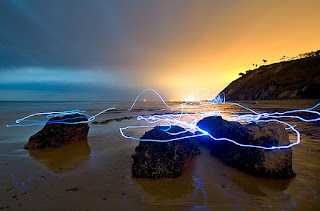 |
Light Painting is a photography technique that can be used to create really astonishing photos. It is a technique whereby the exposure is taken in a dark environment with the use of a light source to create effects that can be captured when the camera is in long exposure.
Light painting photos are fun to create and quit simple to snap, requiring basically the camera and the light source.
Things You Need To Take Light Painting Photos
To create light painting photos you'll basically need to have a camera that can be set to long exposure and a light source of your choice based on the type of painting you want to make.
Common light sources however are bulbs, flashlights or torch. A tripod will also be needed when you want shake-free images.
Ways To Create Light Paintings Photography
There are two main ways to make a light painting image
1. Use your light source to draw the effect you want to create such as letters, numbers, lines etc.
2. Use a torch or flash to selectively light all or part of an object in the scene, causing that object to have a nice glowing effect in the picture.
Instructions For Creating Light Painting
1. Find a dark area that will not be obstructed with unwanted light such - as a car driving by with it's head lights on.
2. Determine which effect you want to create and choose the right light source that will do the job.
3. Put your camera somewhere steady. A tripod is ideal but you can also put your camera on a solid surface like a stand or table.
4. Use your camera in manual mode and set your exposure to a long value. A shutter speed between 5 seconds to a couple of minutes is fine. The longer the exposure the more time you have to paint your picture.
5. For the sharpest image and to minimise ambient light, set your ISO to as low as it goes (e.g. ISO 50, 100, 200 are low settings) and your aperture to a small opening (f/stop numbers like 11, 16, 22)
6. Click to snap
7. Step into the area your camera is aimed at and turn on your light source. Wave around or move the light to create your desired effect. Wherever the light spots a streak will appear in the photo.
Final Notes
Experimentation is Key when it comes to painting with lights, reason being there are different shutter settings, light sources and patterns to get different outcomes. Therefore, you should just get out there and start taking practice, soon you'll master the effects you want to create.
Simple Light Painting Pictures
 |






No comments:
Post a Comment